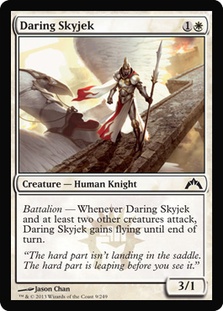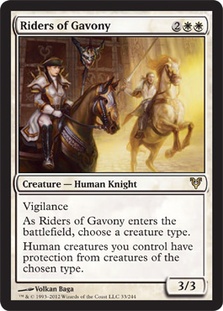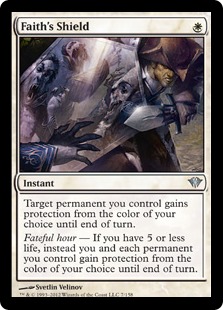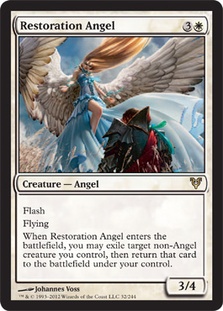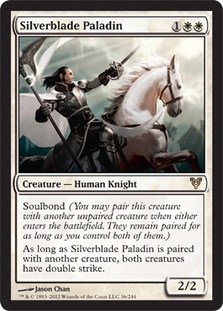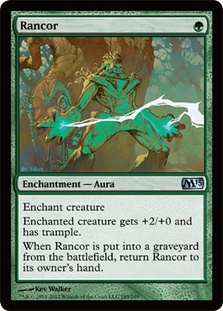When I abandoned Bant Delver, I went looking for another deck to work on. I settled on taking one of the decks I built to be part of the gauntlet, a W/G Humans deck designed for raw speed, and seeing what would happen if I took the deck seriously. I’d been impressed with the clock that the deck could impose, but it had an obvious problem with doing much of anything if the opponent survived your initial rush. Was it possible to rebuild it in such a way that it could preserve its clock without having to give up in the late game?
The solution I found was to cut Avacyn’s Pilgrim. It was important to have at least twelve one-drops to make sure you could come out fast, but Avacyn’s Pilgrim doesn’t actually do anything. It’s a 1/1 that gets caught in the sweep, and it doesn’t meaningfully accelerate you. On turn 2, you’re not that much happier playing a three-drop than a two-drop since Frontline Medic isn’t needed until turn 4 and Silverblade Paladin has nothing to pair with. If you play another one-drop, all you’ve done is play a Memnite because you’re soon out of cards.
Effectively, the deck was flooding late because it had 26 mana sources where it wanted 23-24 and its color requirements were too high for Gavony Township. Yes, I know people at SCG Standard Opens play two Gavony Township with 22 lands in their decks, but that doesn’t actually work and deep down you know that.
There were now two problems. First, I needed to replace Avacyn’s Pilgrim with a better one-drop, and then I needed to figure out how to avoid ending up with other non-impactful creatures. The natural first thing I tried was Experiment One. Experiment One looks amazing in theory, but it requires a lot of work. Champion of the Parish and Boros Elite are 1/1s, so they don’t help, and Silverblade Paladin is only a 2/2. Restoration Angel can help out and potentially get in two shots all the way to 4/4, but you need something else. The third point of power is the key to keeping creatures relevant. If you can be properly blocked by Augur of Bolas or Vampire Nighthawk, you are probably doing it wrong.
There is a two-drop that works perfectly for this, and it is Daring Skyjek (it also allows you to ask if your opponent looks like a man beaten by Skyjeks). Daring Skyjek can only be profitably blocked by Restoration Angel or an enlarged Olivia Voldaren if battalion is triggered, and you have plenty of ways to trigger battalion. Drawing multiples is great since that means you only need one more creature to fly
over their team and it gives you the draw of playing him on turn two, then a Silverblade Paladin on turn three, and hitting them for six on the spot then ten next turn having used only two cards. Combined with Frontline Medic, this gave the deck twelve men that could get Experiment One where you wanted it to be and another six or so that could get it to 2/2 first so you didn’t waste your premium stuff.
I played it in our mock tournament and went 3-2, which made it clear that while I had some good sideboard ideas I had no idea how sideboarding the deck actually worked, especially against red, and that Experiment One was awful, which everyone else reported as well. It just didn’t reach 3/3 often enough, and when it was 1/1 it was terrible. If the deck was going to work, we were going to have to do better. That’s when I remembered that a Human exists that costs one mana and can get to 3/3 whenever you want it to: Wolfbitten Captive.
I put that into the deck, and the difference was obvious right away. This was our man. After that, the only question about the maindeck was what two-drops were best. Many were arguing against Daring Skyjek on the basis of one toughness being terrible, allowing opponents to pick us apart with Izzet Staticaster, Flames of the Firebrand, and Bonfire of the Damned, especially after sideboarding.
It’s amazing how few of those cards actually showed up at the Pro Tour. I’m still not sure I understand it, as I built decks that walked straight into them. In any case, it was time for me to work out my sideboard plans. I started with Jund. I concluded that I had a moderate edge in game 1 against reasonable builds (we were assuming two or three Bonfire of the Damned here), so I had to figure out what to board. My first few attempts got smashed until I realized that the key to the matchup was getting tempo advantage and protecting your key creatures. By sideboarding too aggressively, you played into Jund’s hands. Thus, the correct sideboard was simple: four Faith’s Shield and nothing else. This led to the matchup being moderately in your favor.
Next up was Flash. Matt Costa was our resident Flash expert, and like everyone else we had Boros Reckoner and Harvest Pyre as the new additions. Traditionally, decks like W/G Humans are what Flash eats for breakfast, although due to my having been out of things for some time it was only here in testing that I finally learned how and why this is the case. I still don’t respect the deck as much as I presumably should because it lacks the power I look for and has the tendency to get overrun by the brand of ruthlessness I to bring to the table.
The matchup clearly wasn’t easy because if you extended into Supreme Verdict you could get wiped out, whereas if you didn’t then they could pick you apart with spot removal and Restoration Angel. A creature set that largely ignored Snapcaster Mage and Augur of Bolas helped, but not enough, so game 1 was clearly a struggle. The good news is that if you knew your opponent was on zero or only one Supreme Verdict, you could accept that you would lose to it, and then your opponent was in a lot more trouble. LSV made this point a lot in the Top 8 coverage that Supreme Verdict is almost as good when you don’t have it and they play around it as when they don’t play around it and you do have it.
After sideboarding, I expected to have to deal with more of them, so it was necessary to force multiple unstoppable armies as well as deal with Izzet Staticaster. As with Delver, I was trying to handle cards that turned out not to show up. If I had known that I was dealing with only a few Supreme Verdict and no Izzet Staticaster, I would have been much more excited here. As it was, I looked through the board cards I was considering, decided to try Faith’s Shield and Riders of Gavony, and noticed something when I was using a Restoration Angel to reset the Riders: almost every creature they had was a Wizard. Izzet Staticaster, Boros Reckoner, Augur of Bolas, and Snapcaster Mage all share a creature type.
That meant that Riders of Gavony, if it could be protected from Searing Spear, essentially forced Supreme Verdict, which removed their creatures as well. Faith’s Shield and Restoration Angel provided defenses for him and Frontline Medic since if you kept a Frontline Medic alive they again couldn’t actually fight your army. A second Gavony Township allowed these creatures to quickly get out of range of individual burn spells. You would lose games when they had Supreme Verdict into Sphinx’s Revelation or when their answers lined up well, but you could fight them into the long game and pick up free wins early. I was running even with a version that turned out to be more hostile than the real ones after many games.
Given how good your clock was, you were great at punishing undisciplined decks. As I mentioned with Delver, once you cross the critical threshold of being able to cut through Huntmaster of the Fells, Thragtusk, and Restoration Angel, as this deck does quite well, a lot of people who think they are staying alive are now dead. You hit too fast and too hard for such issues to get in your way unless they’re backed by sweepers. We didn’t know that Wolf Run Bant was a thing, so that left Esper as the last key matchup to be tested.
That one was a bit more of a problem. Game 1 was not good because you were faced with the dilemma you had against Flash only they were stacked everywhere. If you put them to a decision on Supreme Verdict quickly, you lost outright if they had it. If you didn’t, you usually lost even if they didn’t have it because they could bridge to Terminus (or Planar Cleansing). Your follow-up attempts that would work on other decks wouldn’t work against Esper.
The best thing to do game 1 turned out to be to simply try to kill them and hope they don’t have it because waiting is even worse, but it’s not a good place to be. If they know the matchup and can mulligan to find it, it’s that much worse. I tried Garruk Relentless, but that meant too often that a single removal spell could break you up from your clock long enough to bridge to six, and with Planar Cleansing being a thing Garruk Relentless was off the table entirely. I tried Nevermore, which was better, but it is awkward to pause for that and they have Detention Sphere to get back in it. Rootborn Defenses was all right as a singleton for a little help, but it’s no Boros Charm and doesn’t work on Terminus; if you face Planar Cleansing it gets much, much stronger.
Then I uncovered something very strange: the best way to play around Supreme Verdict was Faith’s Shield.
Wait, what?
I didn’t get it either the first few games until I understood the dynamic. The dilemma you’re facing has two horns, the same ones you face against Flash: overcommit and risk the Supreme Verdict or commit just enough and have your battalions and clocks picked apart by Azorius Charm and Ultimate Price. However, if you could protect your guys from their removal, then you could commit a real clock to the board with only three cards. If they hung back to buy time, you could counter their attempt to do so, resulting in a big hit and punishing them even more than more threats would have if they don’t have it. The extra tempo gain from countering their spell means that they have no chance to bridge up to Planar Cleansing or Terminus.
As a result, your matchup is much better. It’s not good but is winnable, and being a bye is a very bad thing to be.
At this point, it seems to be relatively safe to risk having one toughness, so I’d build based on that, which makes the rest of the choices easy. Two Faith’s Shields move to the maindeck since you’re putting them in everywhere, even though that’s a little scary for the curve. If Izzet Staticaster and Bonfire of the Damned return because of The Aristocrats, you’ll have to adjust your two-drops again.
Two Rancor is clearly the right number. You need some of them to provide staying power against sweepers and to provide push through for Restoration Angel in the air or others on the ground, and it’s great when you have a Silverblade Paladin working. But drawing two risks putting you into awkward spots, and there’s no matchup where you actively want more than two after sideboarding other than Reanimator. A full set of Restoration Angel also requires explanation. It looks like it "doesn’t work with anything," but as Sam Black says, it is an amazing card in real Magic games against actual humans. This is one of the key ways that this deck earns the right to "play Magic" rather than just killing you.
On turn 4, you want to pass the turn with Restoration Angel in hand. If you do this, good things can happen to you but remarkably few bad ones. If they sweep, you put the Angel down and hit them for at least three, often six off a Silverblade Paladin or five with a Rancor, in the air, with them out of sweepers and still a turn behind. If they try spot removal, you counter it with upside, as well as if they have some semblance of a good attack or block.
A lot of people are playing Flinthoof Boar, Hellrider, or other 3/3 creatures that Restoration Angel matches up well against, and it can fly over Boros Reckoner to allow you to get proper use of your power boosters. The last important but subtle thing Restoration Angel does is allow you to flip your creatures on turn 4, transitioning from deploying an army to hitting hard. Wolfbitten Captive turns into a potential 6/6, Mayor of Avabruck turns into a 3/3 that takes over games, and they work together on the flip side.
In addition, while Silverblade Paladin isn’t usually thought of as a come into play effect, untapping him while moving around the double strike is often a combat blowout. It’s remarkably rare that you can’t gain advantage of some kind, and even then it is still a fine fighter. You’ll board it out in some of the matchups you want to put in Riders of Gavony due to curve concerns, but that’s about it.
Creatures (33)
- 4 Champion of the Parish
- 4 Mayor of Avabruck
- 2 Thalia, Guardian of Thraben
- 4 Wolfbitten Captive
- 4 Restoration Angel
- 4 Silverblade Paladin
- 4 Boros Elite
- 4 Frontline Medic
- 3 Daring Skyjek
Lands (13)
Spells (14)
- 2 Rancor
- 4 Forest
- 6 Plains
- 2 Faith's Shield

The other two sideboard cards to consider strongly are Rest in Peace and Fiend Hunter. You can’t get everything you want. If you have room, you’d like a third Thalia for when you know you are on the play. One option is to start a Nearheath Pilgrim in order to save a sideboard slot since you often trim a Daring Skyjek for space.
Matchups
Make sure not to have too many noncreature spells in the deck, as Ari Lax warned with his similar but independently arrived at list. If you destroy your ability to generate armies, you do more harm than good.
U/W/R Flash
Described above.
+3 Riders of Gavony
+1 Gavony Township
+2 Faith’s Shield
-1 Boros Elite
-1 Daring Skyjek
-2 Thalia, Guardian of Thraben
-2 Rancor
Exact creature mix depends on how much you expect Izzet Staticaster versus Supreme Verdict.
Jund
Described above.
-1 Boros Elite
-1 Daring Skyjek on the play. On the draw, -2 Thalia, Guardian of Thraben instead, as it is often terrible once Farseek resolves.
Esper Control
Described above.
+2 Faith’s Shield
+2 Nevermore
+2 Rootborn Defenses
-4 Frontline Medic
-1 Boros Elite
-1 Daring Skyjek
Here Thalia is excellent even on the draw. Even this might be slightly over-boarding, especially if space in the board for other matchups is tight.
Human Reanimator
The race is on. Kill them. Nevermore comes in to name Unburial Rites, and Riders of Gavony makes you unblockable, so it comes in over Restoration Angel. If you want more help, let them Rest in Peace or use other graveyard hate to taste.
+2 Nevermore
+3 Riders of Gavony
-1 Faith’s Shield
-4 Restoration Angel
It’s an option to have a Nearheath Pilgrim over the Faith’s Shield simply to shore up the curve; that slot very much wants to be Thalia here.
Gruul / Jund Aggro
Didn’t test this, but it’s a straightforward creature slugfest and race. You’re good at those. First instinct is:
-1 Daring Skyjek
-2 Rancor
Adjust the number of Faith’s Shields to how focused you expect them to be on removal after sideboarding. Skyjek is excellent at blocking Flinthoof Boar and Hellrider, so perhaps he stays in and you trim Boros Elite instead. Your top end is good where it is.
Naya Humans
Say hello to Riders of Gavony. They can have a small speed advantage thanks to Burning-Tree Emissary, but you have a lot more staying power. You’d love Fiend Hunter to stop Champion of the Parish. Rancor is good here since it gives trample to Champion of the Parish. Here is the only place you would actively want the fourth Riders of Gavony. I am very unsure on how many Faith’s Shields are good here, which likely depends on how much removal you expect them to have.
+3 Riders of Gavony
+3 Nearheath Pilgrim
-1 Boros Elite
-1 Daring Skyjek
-2 Thalia, Guardian of Thraben
-2 Restoration Angel
If you want more Faith’s Shields, trim the same cards a little more.
Bant Control
They may look like they won’t need to Supreme Verdict, but they will. Force the issue, and then try to cover their escape. However, they can buy time reasonably, so Nevermore is less good as a defense to that. My guess is:
+2 Rootborn Defenses
+1 Faith’s Shield
-1 Boros Elite
-2 Thalia, Guardian of Thraben on the draw or -2 Daring Skyjek on the play.
Red
I never did figure out the right way to board this. There’s a huge glut at three mana where you want to bring in Loxodon Smiter and Fiend Hunter as answers to Boros Reckoner and Stromkirk Noble, which are quite difficult to block. You bring in any copies of those that you have and lose some number of Silverblade Paladin and Frontline Medic to preserve the curve, as well as swap in Nearheath Pilgrim. First instinct is:
+2 Faith’s Shield
+3 Nearheath Pilgrim
+2 Loxodon Smiter
-2 Rancor
-2 Thalia, Guardian of Thraben
-1 Silverblade Paladin
-1 Boros Elite
Swap out a first Medic and then second Paladin if you have Fiend Hunters available. A key question is whether you’re facing Flames of the Firebrand. If you are, this might be a little soft to that, prompting a trimming of Boros Elite and keeping a bigger high end. The issue is that if they try to play control, you want to raise your curve and play ten+ cards that cost three, whereas if they’re going for Volcanic Strength or otherwise trying for the fast kill, you want to do the opposite.
Naya
You are mostly set up well. If they are going second and running Farseek, Thalia is good; otherwise, it is bad, and you should substitute other cards. The other question is how many Faith’s Shields you should play. Likely best is to raise the curve slightly for Riders of Gavony and Gavony Township with your newly open slots if they are defensive and staying low and going for Nearheath Pilgrim if they are aggressive like the deck that Eric Froehlich played in Montreal.
The Aristocrats
This is a nightmare, although Riders of Gavony on Human can potentially be a big game. All their creatures line up well, and you have no plan against Blasphemous Act or a Demon army. Going for as many free quick wins as possible is likely your best bet, and you certainly shouldn’t be thinking about beating Blasphemous Act unless the game is otherwise in hand. They can stumble and their mana can be painful, or you can get Frontline Medic going while you have the tempo advantage. Boarding out Boros Elite but keeping Daring Skyjek is an attempt to fly over Knight of Infamy and Boros Reckoner as often as possible, and it’s very possible that you want to max out on Faith’s Shields against Orzhov Charm and Tragic Slip.
-2 Thalia, Guardian of Thraben
-2 Boros Elite
+3 Riders of Gavony
+1 Gavony Township
Why didn’t I run this deck at the Pro Tour? There were a few reasons.
First, we found The Aristocrats, which seemed to have a ton of upside. It did a lot of things that were very hard for others to deal with, and that was where the team focused its efforts in the final days.
Second, I was unable to convince anyone else except perhaps Paul Rietzl, who had a natural pro-Human bias, and Gaudenis Vidugiris, who will essentially play whatever I tell him to, that this was the deck to play, and even Paul did little testing with it. Whenever I’ve had a strong deck, it’s been easy to convince my teammates to follow me. In this case, I could barely get them to play games with it, let alone sideboard with it. Reporting results like small advantages against Jund and splitting with Flash didn’t excite them, which is understandable, even though from my perspective I was surviving in realistic worst-case scenarios. When I couldn’t get them to go along, this made me suspect I was making a mistake and it would be better to help get everyone in line behind Sam Black and The Aristocrats instead.
Third, Patrick Chapin, who was our resident Esper expert, was very vocal that this deck was extremely poorly positioned, and it was true. In a field of anti-aggro decks and cards and with Boros Reckoner as the new hotness, was I actually going to play a bunch of white creatures? I had a great version, but it was starting from so far behind.
These two reasons were highly correlated of course. No one at the highest levels wants to play or lose to naked aggression, so a deck like W/G Humans is a very difficult sell. It was hard to get anyone to even take it seriously as an option. Without anyone else willing to work on the deck, it was that much harder to get it the attention required to get it to a place where it could keep pace with the competition.
As the tournament approached, however, I kept having the nagging suspicion that I had been right and that I should have stuck to my guns. If the deck was so poorly positioned, why were far inferior versions of Human decks that people seemed to be boarding very poorly doing reliably well at StarCityGames.com Standard Opens? To what extent had I warped our local decks to make sure they had good answers to strong aggression with this deck and Bant Delver?
We will never know, and given I only managed to 3-3 in Limited, I would likely have lost against teammate Matt Sperling and The Aristocrats on Day 1 and missed regardless of how strong the deck otherwise was. That’s certainly the deck you don’t want to face the most going forward. Either way, however, this is a big upgrade to the Humans, so it’s worth taking seriously as an option.

